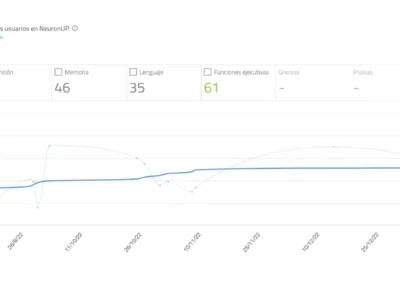Jesús M. Cortes, Ikerbasque Professor at the Biocruces-Bizkaia Health Research Institute and Head of the Unit of R&D&I at NeuronUP, explains in this Press Conference the results on predicting cognitive decline with NeuronUP that have just been published in the prestigious British journal Journal of Neuropsychology.
What were the main findings of this study?
The motivation of the study was to rigorously understand to what extent the different cognitive training materials developed by NeuronUP could or could not be used to predict cognitive decline one year after using NeuronUP.
Of the 203 different cognitive training materials studied, we have understood that some materials perform better than others. For example, materials for training processing speed and attention (in its three forms: selective, alternating, or sustained) and executive function had predictive power with area under the curve accuracies greater than 0.89, which are very high compared to previous studies.
Moreover, in more specific pathologies, we found differences such as selective attention predicts cognitive decline at one year very well in Parkinson’s disease, but not in Alzheimer’s disease, where most existing materials predict cognitive decline moderately. We also studied populations with multiple sclerosis or Down syndrome.
On the other hand, this study has allowed us to develop a data engineering infrastructure within NeuronUP, streamlining the entire operation, and creating a specific data unit, where there is already staff dedicated within this unit.
Why was the Journal of Neuropsychology chosen to publish these results?
The Journal of Neuropsychology is a journal of the British Psychological Society, which is one of the oldest and most respected psychology organizations in the world.
Founded in 1901 and with more than 60,000 members, it is a professional organization for psychologists in the United Kingdom, which organizes a wide range of activities and services for its members, including continuing education, research and the promotion of psychology.
It is a strong advocate for promoting psychology for the public good and works closely with other organizations and government agencies to improve mental health and wellbeing in the United Kingdom and worldwide.
The British Psychological Society manages several prestigious, high-impact scientific journals covering clinical psychology, neurodevelopmental psychology, educational psychology, health psychology, social psychology, and neuropsychology. It is, without a doubt, a well-established forum of quality and prestige for neuropsychology professionals.
On the other hand, our research uses a disruptive technology in neuropsychology based on Real World Data, and this has penalized us to some extent considerably. Specifically, one of the reviewers was very demanding and rigid, and it was very difficult for us to publish our results in this journal. But this was a risk we decided to take, since, in a way, our strategy was that, if a journal consolidated in the community published our work, the community of professionals and researchers would be more receptive to our methodology.
Why is technology based on Real World Data disruptive?
First I would like to emphasize what Real World Data (RWD) is and why it is different from the typical methodology in clinical research. RWD refers to data collected outside the controlled environment of a clinical study, as occurs in everyday clinical practice or in traditional clinical research.
RWD mixes data from electronic health records, online platforms, surveys, health insurers, among others. Unlike data collected in controlled clinical trials, which have very little generalizability to populations different from those studied, RWD can provide a more accurate and generalizable view of how a treatment or intervention behaves in the real population.
The drawbacks are that RWD is highly heterogeneous and requires the use of more agile non-traditional technologies such as machine learning or artificial intelligence.
RWD is a disruptive technology because it allows access to a large volume of data and a wide variety of patients, which enables a better characterization of populations and a better understanding of the interactions between treatments and comorbidities.
It can also help to identify new therapeutic indications and to assess the safety and efficacy of treatments in an environment closer to real clinical practice.
On the other hand, it faces new challenges, such as greater complexity in data collection and cleaning, in the analysis of the data itself, less control over confounding factors, and legislation not designed for RWD, with recurring problems of data privacy and security.
How was cognitive decline measured in your study?
Cognitive decline in our study was defined based on population performance data when completing NeuronUP cognitive training materials. Basically, in cohorts of several tens of thousands of participants, we can clearly define what is normal and what is decline by simply defining percentiles in each patient’s scores with respect to the population.
Each participant’s performance was measured using the NeuronUP Score, the score we use to measure users’ progress in NeuronUP. It is an index between 0 and 100, different for each participant, and calculated by a formula that combines correct responses, time taken to complete the test, and the difficulty level of the test. NeuronUP Score is a novel quantitative index that simplifies participant performance and facilitates comparisons in follow-up, allowing the modeling of longitudinal data of the same participant and obtaining precise trajectories of individual performance.
How do you think your study could contribute to a better understanding of the causes of cognitive decline?
This is a very ambitious question and we still do not know how to answer it. To explain the causes of cognitive decline we should study the genetic and environmental factors related to this condition. We should also address the different forms of cognitive decline, such as dementia, and the differences in the underlying causes of each type.
In addition, changes in the brain and cognitive and neuropsychological function between individuals with and without cognitive decline should be characterized, as well as their peculiarities in specific populations, such as older adults or people with certain underlying medical disorders, to identify risk factors specific to this condition.
Furthermore, we should also characterize therapeutic interventions and their effectiveness in improving or preventing cognitive decline. While it is true that more research is still needed in this area, our article using RWD and NeuronUP Score is a good starting point, and motivates the need for further studies in the future using NeuronUP Score and specific cohorts to advance on this issue.
How do you think your findings could be used to improve medical care for people with cognitive decline?
Quantitative studies to predict cognitive decline in the general population with high accuracy up to 12 months before it occurs are very useful, for example, to identify people at risk of developing cognitive decline in advance.
This would allow early intervention to delay decline, design personalized prevention and treatment programs for people at higher risk of cognitive decline, monitor the progress of people with cognitive decline over time to assess treatment effectiveness, identify modifiable risk factors and develop interventions to reduce the risk of cognitive decline, and also help clinicians make informed decisions about the treatment of people with cognitive decline.
What steps are being taken to carry out more research within the NeuronUP R&D&I Unit?
In this unit we began working in 2018 with funding from the Centre for Industrial Technological Development of Spain (CDTI), dependent on the Ministry of Science, Innovation and Universities, and from the La Rioja Economic Development Agency ADER, as well as internal funding from NeuronUP.
During this time, we have managed to optimize many aspects of data collection, engineering and monitoring, as well as quantification and visualization, of extremely high value for the clinical professional.
In addition, we have begun working with several leading research centers around the world (national and international) on different research projects, such as detection of atypical subjects (outliers) and their follow-up in the general population, validation of NeuronUP Score using standard neuropsychological tests, or classification of each participant’s trajectories according to their performance on NeuronUP.
Without a doubt, in the coming years we will be able to offer new data-driven features for clinical professionals.

More information about Jesús Cortes and his work in Neuroscience and Biomedicine:
If you want more information about the published study, take a look at the following article:
“This article has been translated. Link to the original article in Spanish:”
Jesús Cortes: “Este estudio puede ayudar a identificar con anticipación a las personas en riesgo de desarrollar deterioro cognitivo”







 Neurological examination techniques: basic concepts and clinical applicability
Neurological examination techniques: basic concepts and clinical applicability
Leave a Reply